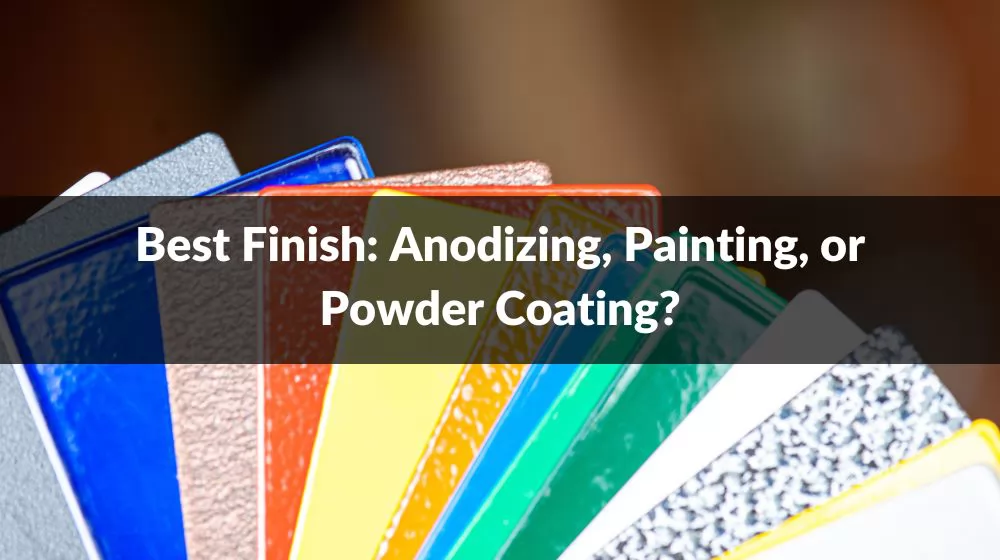
.png)

.png)
.png)


-
.png) 0086-757-85407388
0086-757-85407388 -

-
 terrychen@wintoly.com
terrychen@wintoly.com


.png)

.png)
.png)


.png)




Table of contents:
Choosing the optimal surface finishing method for a product is a critical decision that involves considering various factors such as durability, aesthetics, and application requirements. Among the popular options are anodizing, painting, and powder coating, each offering unique characteristics. In this exploration, we delve into the strengths and considerations of these surface finishing methods to determine the best finish for diverse applications.
Surface finishing plays a pivotal role in enhancing the durability, appearance, and overall quality of metal products. Manufacturers employ various techniques to achieve the desired finish, and three popular methods stand out: anodizing, painting, and powder coating. In this overview, we will delve into the fundamental aspects of each process, shedding light on their unique characteristics, applications, and benefits.
Anodizing is a surface finishing technique widely used to enhance the properties of metals, primarily aluminum. This electrochemical process creates a protective oxide layer on the metal's surface, imparting several distinctive characteristics that contribute to its popularity in various industries.
1. Enhanced Corrosion Resistance
2. Increased Durability
3. Aesthetic Appeal
4. Thermal Insulation
5. Eco-Friendly Process
6. Electrical Insulation
While anodizing is a widely used and beneficial surface finishing process, it is essential to consider its limitations to make informed decisions about its application. Despite its many advantages, anodizing may not be suitable for every situation. Here are some of the key limitations associated with anodizing:
1. Limited Color Range:
Although anodizing allows for a variety of colors through dyeing, the color range is somewhat limited compared to other finishing methods, such as painting. Achieving specific and vibrant colors can be challenging, and the final appearance may not match certain aesthetic preferences.
2. Dimensional Changes:
The anodizing process involves the buildup of the oxide layer on the metal surface. This can result in dimensional changes, with the final product being slightly larger than its original dimensions. Manufacturers need to account for this expansion when tight tolerances are critical in the design.
3. Susceptibility to Scratching:
While anodized surfaces are generally durable, they are not immune to scratching and abrasion. Heavy or sharp objects can cause damage to the anodized layer, exposing the underlying metal. This susceptibility to scratching may limit the use of anodizing in applications where the surface is prone to frequent contact with abrasive materials.
4. Difficulty in Repair:
In the event of damage to an anodized surface, repairing it can be challenging. Unlike painting or powder coating, where touch-ups are relatively straightforward, anodizing typically requires recoating the entire surface to achieve a consistent appearance. This can be a disadvantage in situations where localized repairs are necessary.
5. Cost Considerations:
Anodizing can be more expensive than some alternative finishing methods, particularly when intricate designs, multiple colors, or stringent quality control measures are involved. The initial investment in anodizing equipment and the energy-intensive nature of the process can contribute to higher production costs.
6. Limited Substrate Compatibility:
While anodizing is well-suited for aluminum, it may not be suitable for all types of metals. Some metals do not readily form a stable oxide layer through the anodizing process, limiting the range of substrates that can benefit from this surface finishing technique.
7. Chemical Sensitivity:
Certain chemicals, especially alkaline solutions, can damage the anodized layer. This chemical sensitivity should be considered in applications where the anodized material may come into contact with aggressive substances.
Painting Process:
The painting process is a versatile and widely used method for surface finishing that involves applying a liquid paint coating to a substrate. This method provides manufacturers with the flexibility to achieve a broad spectrum of colors, textures, and finishes, making it suitable for diverse applications across various industries. Here is an overview of the typical painting process:
Surface Preparation:
Before painting, the substrate undergoes thorough surface preparation. This involves cleaning the surface to remove contaminants, such as dirt, grease, or rust, and may include processes like sanding or abrasive blasting to create an optimal surface for paint adhesion.
Priming:
Priming is often the next step in the process. Primers help improve adhesion, enhance corrosion resistance, and provide a uniform base for the topcoat. The type of primer used depends on the substrate material and the intended application.
Paint Application:
The chosen paint is applied to the primed surface using various methods, including spray guns, brushes, or rollers. The application method depends on factors such as the size and shape of the object being painted, the desired finish, and the efficiency of the painting process.
Curing or Drying:
After application, the painted surface undergoes a curing or drying process. This step is crucial for the paint to form a durable and protective coating. Curing may involve air drying, heat curing, or a combination of both, depending on the type of paint used.
Topcoat Application (Optional):
In some cases, a topcoat may be applied to provide additional protection, gloss, or specific performance characteristics. This step is optional and depends on the requirements of the final product.
Characteristics of Painted Surfaces:
The painting process imparts several key characteristics to the finished product, making it a popular choice for a wide range of applications:
Aesthetic Versatility:
Painting offers unparalleled aesthetic versatility, allowing manufacturers to achieve an extensive range of colors and finishes. This makes it ideal for industries where visual appeal is a critical factor, such as automotive, consumer goods, and architectural applications.
Customization:
Manufacturers can easily customize painted surfaces to meet specific design requirements. Customization options include matte or glossy finishes, metallic effects, and textured surfaces.
Corrosion Resistance:
Properly applied paint coatings provide effective corrosion resistance, protecting the underlying substrate from environmental factors. This is particularly important for outdoor applications or products exposed to harsh weather conditions.
Ease of Repair and Touch-Ups:
One of the advantages of painting is the ease of repair and touch-ups. Damaged or scratched areas can be addressed by repainting specific sections without the need for extensive rework.
Cost-Effectiveness:
Painting is often a cost-effective surface finishing solution, especially for large-scale production. The relatively lower equipment costs and ease of application contribute to its economic viability.
Substrate Compatibility:
Painting is suitable for a wide range of substrates, including metals, plastics, wood, and composite materials. This versatility makes it a preferred choice for multi-material products.
Advantages of Painting:
Aesthetic Versatility:
Painting allows for a wide range of colors, finishes, and textures, providing unparalleled aesthetic versatility. This makes it suitable for industries where visual appeal is a crucial factor.
Customization:
Manufacturers can easily customize painted surfaces to meet specific design requirements. This includes achieving different gloss levels, incorporating metallic effects, and creating textured finishes.
Corrosion Resistance:
Properly applied paint coatings offer effective corrosion resistance, protecting the underlying substrate from environmental factors. This is particularly important for products exposed to harsh weather conditions.
Ease of Repair and Touch-Ups:
Painted surfaces are relatively easy to repair and touch up. Damaged or scratched areas can be addressed by repainting specific sections without the need for extensive rework.
Cost-Effectiveness:
Painting is often a cost-effective surface finishing solution, especially for large-scale production. The relatively lower equipment costs and ease of application contribute to its economic viability.
Substrate Compatibility:
Painting is suitable for a wide range of substrates, including metals, plastics, wood, and composite materials. This versatility makes it a preferred choice for applications involving different materials.
Quick Application:
The painting process is generally faster compared to some other finishing methods, contributing to quicker production turnaround times.
Disadvantages of Painting:
Limited Durability in Harsh Environments:
While paint provides protection, it may not offer the same level of durability as some other finishing methods in extremely harsh environments or conditions.
Susceptibility to Scratching and Chipping:
Painted surfaces can be susceptible to scratching and chipping, especially in high-impact or abrasive situations.
Environmental Impact:
Certain paints may contain volatile organic compounds (VOCs) or other environmentally harmful substances. Eco-friendly paint options are available, but careful consideration is necessary.
Complexity in Multilayer Applications:
Achieving certain complex multilayer finishes may require meticulous application processes, increasing the complexity and potential for imperfections.
Surface Preparation Requirements:
Proper surface preparation is crucial for paint adhesion. Inadequate preparation can lead to poor adhesion, reducing the overall effectiveness of the paint coating.
Dimensional Changes:
The thickness of paint can result in dimensional changes, which may be a consideration in applications with tight tolerances.
Curing Time:
Depending on the type of paint used, curing times can vary. Some paints require longer curing times, affecting overall production schedules.
Understanding both the advantages and disadvantages of painting is essential for making informed decisions in selecting the most appropriate surface finishing method for specific applications. Consideration of factors such as environmental conditions, desired aesthetics, and durability requirements will help determine whether painting aligns with the intended goals for a given project.
There are three key phases to the powder coating process:
PHASE ONE : Pre-treatment
This stage is vital in allowing the paint finish to perform to its full potential. All paints are porous and will over time allow atmospheric conditions to permeate through the coating onto the metal. To safeguard against this, all substrates are chemically pre-treated in order to protect against corrosion and promote good adhesion.
PRE-TREATMENT DETAILS
The pre-treatment at Powder Coatings is a classic seven stage immersion system where work is loaded into cages before being dipped through seven tanks.
1. DE- GREASE
All metal substrates must be clean prior to any other stage. All grease or lubricant residue from the manufacturing process is removed.
2. WATER RINSE
Between each chemical rinse, a water rinse is necessary to clean the work from any chemical residue.
3. ACID ETCH (Aluminium only)
The surface of the Aluminium is de-oxidised and any contaminants on the surface of the alloy are removed. Etching of the aluminium is vital in preparing the substrate for the oxsilan stage.
4. WATER RINSE
5. DEMINERALISED WATER RINSE
Before entering the tank, the water is passed through a plant that removes all heavy metals and minerals. The water is kept at a conductivity of less than 200 microsiemens. This stage is vital in ensuring the ongoing integrity of the Oxsilan stage.
6. OXSILAN
The substrate is coated by a Silane & Zirconium based polymer. This bonds to the substrate providing the metal with excellent corrosion protection whilst promoting good adhesion.
7. DEMINERALISED WATER RINSE
The water is kept at a conductivity of less than 30 microsiemens. Rinsing the metal completely clean ensures that in the drying stage no contaminants will deposit onto the surface of the metal. Surface impurities could affect the adhesion and the performance of the cured paint finish, Regardless of how good the stages prior to this are, unless the de mineralised rinse is well maintained, the paint will not perform to its full potential.
8. DRYING OVEN
Hot air is circulated around the work to dry the metal off.
PHASE TWO : Coating
After pre-treatment the metal is suspended on a conveyorised production line and passes into the spray booth for coating. The powder which is held in a fluidised hopper bed is carried to the spray gun using compressed air. As the powder passes out of the gun, the particles are charged and therefore attracted to the earthed piece of metal. This creates an even coating as it wraps around the work piece.
PHASE THREE : Curing
After coating, the production line moves the work into the tunnel oven where it is baked. Once the curing is complete the substrate is inspected for defects, paint thickness, colour and gloss level. Provided there are no issues, the product is packed and made ready for despatch.
Durable Finish:
Powder coating provides a highly durable finish that is resistant to chipping, scratching, fading, and other forms of wear. The cured powder forms a tough, resilient coating that contributes to the longevity of the coated product.
Wide Range of Colors and Finishes:
Powder coatings offer a diverse range of colors, textures, and finishes. This versatility allows for customization to meet specific aesthetic requirements, making it suitable for a variety of applications across different industries.
Uniform Coating Thickness:
The electrostatic application of powder ensures a uniform coating thickness on all surfaces, including complex shapes and hard-to-reach areas. This uniformity contributes to a consistent appearance and performance of the coated product.
Environmental Friendliness:
Powder coating is an environmentally friendly option as it typically contains little to no volatile organic compounds (VOCs). The process generates minimal waste, and overspray can often be collected and reused, reducing environmental impact compared to traditional liquid coatings.
Cost Efficiency:
The powder coating process is cost-effective in various ways. It reduces material wastage, as unused powder can be reclaimed and reused. Additionally, the elimination of solvents and the ability to coat multiple parts simultaneously contribute to overall cost savings.
Excellent Corrosion Resistance:
Powder-coated surfaces exhibit excellent resistance to corrosion. The cured powder creates a protective barrier that shields the substrate from moisture, chemicals, and other environmental factors, making it suitable for outdoor and harsh environments.
Efficient Application Process:
The electrostatic application of powder allows for efficient coverage on complex shapes and intricate parts. This process minimizes the need for multiple coats, resulting in faster production times and increased efficiency.
Thermal and Electrical Insulation:
Depending on the specific formulation, powder coatings can provide thermal and electrical insulation properties. This makes them suitable for applications where these characteristics are essential, such as in electronic components.
Reduced Health and Safety Risks:
Unlike liquid coatings that may contain harmful solvents, powder coatings are often solvent-free or low in VOCs, reducing health and safety risks for both workers and the environment. This contributes to a healthier and safer workplace.
Versatility Across Substrates:
Powder coating can be applied to a wide range of substrates, including metals, plastics, wood, and composites. This versatility makes it suitable for diverse industries, from automotive and appliances to furniture and architectural components.
Choosing the right surface finishing method is a crucial decision that impacts the aesthetics, durability, and performance of a product. Anodizing, painting, and powder coating are three distinct techniques with their unique characteristics. Here's a comparative analysis to help you make an informed decision based on your specific requirements:
1. Durability:
Anodizing: Offers excellent durability by creating a hard, corrosion-resistant oxide layer on the metal surface. Ideal for applications requiring long-lasting protection against environmental factors.
Painting: Provides good durability, but may be susceptible to chipping and scratching. The level of durability depends on the type of paint and the application process.
Powder Coating: Known for its robust and durable finish, offering resistance to chipping, scratching, and fading. Powder coating provides similar or even superior durability compared to anodizing.
2. Aesthetic Options:
Anodizing: Limited color range, but can achieve various shades through the use of dyes. Often preferred for a sleek, metallic appearance.
Painting: Offers a wide range of colors, finishes, and textures, providing extensive aesthetic flexibility. Ideal for applications where customization and visual appeal are paramount.
Powder Coating: Provides a diverse range of colors, textures, and finishes. The electrostatic application allows for even coverage on complex shapes, making it suitable for achieving specific aesthetic requirements.
3. Application Versatility:
Anodizing: Primarily used for aluminum and its alloys. Limited applicability to other metals.
Painting: Versatile and applicable to various substrates, including metals, plastics, wood, and composites.
Powder Coating: Highly versatile, suitable for a broad range of substrates, including metals, plastics, and composites. The electrostatic application ensures even coverage on complex surfaces.
4. Environmental Impact:
Anodizing: Generally considered environmentally friendly, involving minimal waste and often using recyclable chemicals.
Painting: May involve the use of solvents with potential environmental impact. Eco-friendly paint options are available, but careful consideration is necessary.
Powder Coating: Considered environmentally friendly due to low or no VOCs and the ability to reclaim and reuse overspray, reducing waste.
5. Surface Preparation:
Anodizing: Requires thorough cleaning and pre-treatment to ensure proper adhesion.
Painting: Requires surface preparation, including cleaning and priming, to achieve optimal adhesion.
Powder Coating: Requires surface preparation, such as cleaning and, in some cases, pre-treatment. The electrostatic application ensures effective coverage.
6. Cost Considerations:
Anodizing: Can be cost-effective for specific applications, but the cost may vary based on factors such as size and complexity.
Painting: Often cost-effective, especially for large-scale production. Initial equipment costs are generally lower than anodizing.
Powder Coating: Initial equipment costs may be higher, but the process is cost-effective in the long run due to material efficiency and reduced labor requirements.
7. Repair and Maintenance:
Anodizing: Limited repair options. Damaged areas may require recoating of the entire surface.
Painting: Relatively easy to repair and touch up. Localized repairs can be performed without recoating the entire surface.
Powder Coating: Repairs can be challenging, similar to anodizing. Localized damage often necessitates recoating the entire surface.
Each surface finishing method—Anodizing, Painting, and Powder Coating—finds its niche in various industries and applications due to its specific characteristics. Here's a breakdown of their primary application areas:
1. Anodizing:
Aerospace: Anodized aluminum is widely used in the aerospace industry due to its lightweight properties, corrosion resistance, and ability to withstand harsh environmental conditions.
Automotive: Anodizing is employed in automotive components to enhance corrosion resistance and provide a durable finish, particularly in parts exposed to road salt and weathering.
Architectural: Anodized aluminum is popular in architectural applications for its aesthetic appeal, durability, and resistance to fading. Commonly used in building facades, window frames, and decorative elements.
Electronics: Anodizing is utilized in electronic components to provide electrical insulation and corrosion resistance. The thin oxide layer allows for precision coating without affecting tight tolerances.
2. Painting:
Automotive: Painting is extensively used in the automotive industry for its versatility in achieving various colors, finishes, and custom designs. It is applied to vehicle bodies, parts, and accessories.
Furniture: Painting is a common choice for wooden and metal furniture, providing aesthetic customization and protection against wear and tear.
Consumer Goods: Various consumer goods, such as appliances, electronics, and household items, are painted for both functional and aesthetic purposes.
Building and Construction: Painting is employed in construction for coating materials such as steel, wood, and concrete, offering protection against the elements and contributing to the overall appearance.
3. Powder Coating:
Metal Fabrication: Powder coating is widely used in metal fabrication for its durable and protective finish. It is applied to metal furniture, shelving, and structural components.
Appliances: Household appliances like refrigerators, ovens, and washing machines often feature powder-coated surfaces for both aesthetic appeal and durability.
Outdoor Equipment: Powder coating is ideal for outdoor equipment such as garden furniture, playground structures, and fencing due to its resistance to weathering and corrosion.
Automotive: Powder coating is applied to automotive components, including wheels, rims, and chassis, providing a durable and aesthetically pleasing finish.
Architectural Structures: Powder coating is commonly used in architectural applications for coating metal structures, railings, and outdoor fixtures, contributing to both durability and design.
The choice of the best surface treatment (whether anodized, painted or powder coated) depends on the specific needs and priorities of the current application. Each method has its advantages and limitations, as well as factors such as durability, customization and environmental impact. If you have any powder coating needs, please contact Wintoly!

 terrychen@wintoly.com
terrychen@wintoly.com
.png) 0086-757-85407388
0086-757-85407388
 6 Chaoyang Rd., National Demonstration Eco-industrialzone, Nanhai, Foshan,Guangdong,China
6 Chaoyang Rd., National Demonstration Eco-industrialzone, Nanhai, Foshan,Guangdong,China

.png)
